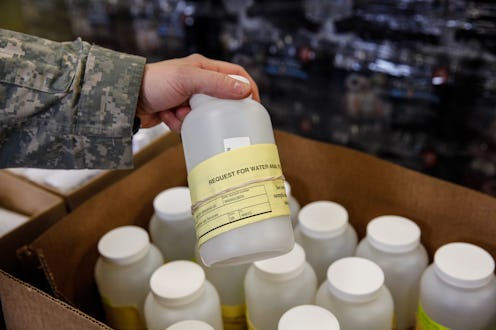News
How Did Flint's Water Get Poisoned?
Arguably one of the worst environmental disasters in the United States. in recent years finally came to a head this month, but only after residents of Flint, Michigan, went months drinking water contaminated with lead and Democratic candidates spoke out on national television at their primary debate. With the announcement on Thursday that the Environmental Protection Agency's regional director will step down from her role, officials appear, at least, to be taking responsibility for the poisoned water supply. The story behind how the people of Flint started seeing brown water goes back almost two years. It's only now, however, that people around the globe are able to ask the same question that Flint residents have been posing for awhile: How did Flint's water get poisoned?
The horrendous decision to beat all poorly made decisions happened in the spring of 2014. Actually, the decision to start it all was in 2013, when Flint's city council voted to join a new, less costly water system that would bring water from Lake Huron for use in the city. Voting to join the Karegnondi Water Authority presented somewhat of a problem, though, since the Michigan city wouldn't be able to connect to the system until several years later.
The plan lay in switching Flint over from its then-source, the City of Detroit's water, to water from the local Flint River. Residents found the change hard to believe, keeping in mind that cracks about the river's filth were not uncommon. "We thought it was a joke," Flint resident Rhonda Kelso told CNN. "People my age and older, thought 'They're not going to do that.'" And filth was not the wrong word to describe Flint River. Residents saw brown, oddly-smelling water coming out of their faucets almost immediately after the change, but city officials assured them that the supply was OK to drink, according to the New York Times.
This is not an emergency. If a situation arises where the water is no longer safe to drink, you will be notified within 24 hours.
If only that "not an emergency" bit were true. This is what was going on in the pipes running from the Flint River. When water is highly corrosive, it can facilitate the leaching of poisonous metals commonly found in piping systems into that water. And the ridiculously corrosive water running from the Flint River turned out to be eroding both the iron and the lead in the water mains and service lines to Flint homes.
Officials will now take on the monumental task of undoing whatever damage can be undone, but with some of the water having tested for lead contamination more than twice the amount required for the EPA to classify it as hazardous waste, the prospects of doing so seem quite limited. For so many residents who continued to consume the poisonous supply, the damage is irreversible.
